Time to further explore the West Coast! On top of our must-see list: Eighty Mile Beach!
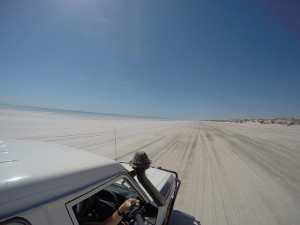 We stayed at the Eighty Mile Beach Caravan Park, situated at the end of a rough road (but we saw cracky vans at snail-speed advancing towards the sea). The beach is very important for (millions of) migratory birds coming from the Arctic Circle (a 10 to 15000 kms non-stop flight away!). Eighty Mile Beach is the longest uninterrupted beach in WA, covering 220 kms of beach. Unfortunately we didn’t come in the right time of year to see nestling turtles (October to April) or hatching turtles (between February and July). A female turtle born here, will come back to the same beach to nestle … How amazing! But we were absolutely over the moon to see dolphins at literally one meter from the breaking line, at sunset! Stunning!!
We stayed at the Eighty Mile Beach Caravan Park, situated at the end of a rough road (but we saw cracky vans at snail-speed advancing towards the sea). The beach is very important for (millions of) migratory birds coming from the Arctic Circle (a 10 to 15000 kms non-stop flight away!). Eighty Mile Beach is the longest uninterrupted beach in WA, covering 220 kms of beach. Unfortunately we didn’t come in the right time of year to see nestling turtles (October to April) or hatching turtles (between February and July). A female turtle born here, will come back to the same beach to nestle … How amazing! But we were absolutely over the moon to see dolphins at literally one meter from the breaking line, at sunset! Stunning!!
Further down along the coast, we also stopped at Barn Hill. Most of the free camp spots are situated at the high way, but why on earth would you sleep there if you can sleep at a (relatively cheap) caravan park at the beach? The road in was quite corrugated, but not a problem for us! However, with a caravan at the back, we would think twice before driving so far out … The hill has a strange rock on top of it, which was left there by an explorer in the late 19th Century. A landmark is a landmark, isn’t it?
This absolutely beautiful part of Australia ends at Port Hedland, an industrial city as we haven’t seen much of these. Only Mount Isa and Port Augusta are similar. It might be important for the development of Australia, but one cannot deny this is devastating for the pristine environment, both in the water as on land. Australia is dual when it comes to the conservation of their natural wealth … On the one hand there are so many national and conservation parks, and nature reserves. On the other hand, it seems the industry has a dominant position and can do just whatever they like, be it in or outside protected land (or water) … Port Hedland has one of the largest harbours in the world, so we thought we could stock some well deserved fresh food. Well … let’s say this 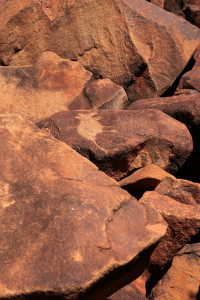 wasn’t exactly the case.
wasn’t exactly the case.
Extremely expensive, small supermarkets with little fresh food. But … We did find delicious Belgian waffles!!!We decided not to stay at this awful city (where caravan parks are equally expensive as supermarkets, which is not a problem for them since workers fly in and out constantly to stay for weeks at those places). Karratha, about 200 kms further south on the Pilbara Coast, on the tip of the Dampier Peninsula, was our next destination. When we arrived at the caravan park, we were told to be aware of snakes …
Just the other day, one was seen making its way through the beautiful grass (yes, grass can be beautiful, especially in countries where the land is mainly red and dusty). Karratha is a small town, but with a very interesting place to visit: the Murujuga National Park. It is not a park with a lot of natural wonders, but with the largest concentration of rock art in the world. The drawings are believed to be more than 30,000 years old! At first, we had troubles to find them, since we didn’t know what we were looking for. But once you discover one, it is really hard not to see all the others! Fascinating! Close by Hearson’s Cove is recommended as a good swimming spot, but we didn’t think it was that special.
It is possible to visit the famous Karijini NP and the smaller Millstream Chichester from Port Hedland, and than follow the route to Karratha, but it is a huge detour of about 1000 kms … And their are a lot of mines as wel … That’s the thing in WA: every worth-to-visit-place is located at a huge distance from the place you were the other day!
Exmouth was next on our map, another 550 kms, with nothing in between (and you have to drive a part of the same route back to get to the highway). But it was worth every kilometer we drove! We didn’t go on a whale watch tour, and we were just too late to see the famous whale sharks, but we did enjoy the Ningaloo Reef every second we were there! Exmouth is situated at two nature parks: the Cape Rang NP and the Ningaloo Marine Park. They are part of the Ningaloo Coast World Heritage Area.
The biggest fish (up to 12 meters) in the world calls the Marine Park home between March and August: the whale shark. It is one of the few places where you can snorkel with them. But we came too late to meet them . Also inhabitants of this place: sea turtles and manta rays. And it must be the easiest place to get to the reef as it starts basically at the beach. Turquoise Bay is a good place for the inexperienced snorkeler!
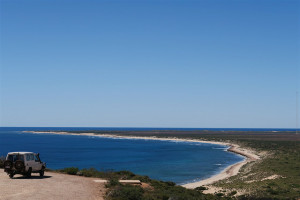 Exmouth kindly reminded us at home with the Vlaming Head Lighthouse. The hill on which the lighthouse is build, offers amazing views over the reef and the Cape Range NP. From here, you can not only see the whales splashing around, but also clearly see the strange towers you pass when driving towards the national park (for which you need a pass!). This is the (world’s largest) Very Low Frequency transmitter, built during the heights of the Cold War to plug a gap in the US Navy communications network (nuclear-powered submarines you know), and the reason why Exmouth was ‘created’ as a town.
Exmouth kindly reminded us at home with the Vlaming Head Lighthouse. The hill on which the lighthouse is build, offers amazing views over the reef and the Cape Range NP. From here, you can not only see the whales splashing around, but also clearly see the strange towers you pass when driving towards the national park (for which you need a pass!). This is the (world’s largest) Very Low Frequency transmitter, built during the heights of the Cold War to plug a gap in the US Navy communications network (nuclear-powered submarines you know), and the reason why Exmouth was ‘created’ as a town.
The VLF communication station no longer has a military function, but is still in operation. So, before the arrival of the VLF station, the lighthouse was the only place in a very wide area where people lived … Sad stories of the lonely lives of those people can be read at the foot of the lightkeeper’s cottage. Interesting fact to know about Exmouth: it holds the record of the strongest wind gust recorded on the Australian main land with 267 km/h!
We are over halfway of the West Coast. Carnarvon is a town we look forward to! We missed the abundance of fresh fruits and veggies for a long time now, but Carnarvon is known for its plantations of all sorts of fresh produce. Due to a cyclone just a few months earlier, the plantations of bananas have not recovered yet, but there are a lot of alternatives! The market we first went was a bit disappointing (we Europeans are just spoiled when it comes to fresh produce markets!), but when we drove along the different farms (around the North and South River – arms of the Gascoyne River), we found about everything we wished for. Even organic!
Be sure to obey the signs at the entrances of the plantations to prevent the spread of diseases. That river is kind of strange: the Gascoyne looks like a massive dried riverbed, but it isn’t … The water actually sits underground with sand on top of it to protect it from evaporation. There are a few other sightings in town: the One Mile Jetty (which you are suppose to pay for to walk on – but important for the history of the town since it was the place where the port was built), Pelican Point, Chinaman’s Pool, some beaches.
Fishing is the most popular activity around here, and according to the stories and boxes filled with fish at the caravan park, a lucrative activity 🙂 By the way, we loved the caravan park (Coral Coast Tourist Park)! Clean, friendly reception, big showers, and the most important: good neighbours! Those people really looked after us! The notorious ‘Grey Nomads’. Well, we just met the right people at the right time! And we got to know the tawny frogmouth. Ugly, but special for us since we never saw this bird before.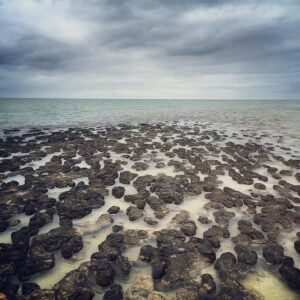
Driving out of town, further south, one cannot miss the huge satellite dishes. The OTC dish or Earth Tracking Station, was built in collaboration with NASA in the ’60’s. Carnarvon actually helped to get the first man on the moon in 1969! Today, you can visit the small museum, opened by Buzz Aldrin. A bit further away, about 500 kms one way, the biggest monolith in the world – Mount Augustus – is at least a thousand times less visited than Uluru.
After some relaxing days in Carnarvon we decided to go ahead and look for another place high on our to-see-list: Hamelin Pool. The highway follows the shores of the Shark Bay Marine Park (World Heritage listed), but there isn’t much to see about the Marine Park. Off course, it is a Marine Park, so the most important sightings are to be found under the surface! Shark Bay has for example the world’s largest seagrass banks! Shark Bay is quite important for marine wildlife. A popular place on the peninsula is Monkey Mia, but we didn’t visit it. Feeding so-called ‘wild’ dolphins, just to get close to them, is not our type of perfect activity.
Hamelin Pool however was beyond imagination! Even when you’re there, and watching it with your own eyes, you can’t comprehend what you’re looking at exactly … Hamelin Pool is World Heritage Listed for a good reason. The oldest living creatures on Earth. Over 3500 million (!!) years old. The stromatolites are microbes and form a kind of rock structure. They survive here due to the very saline water. There are only a few places on the planet where you can see these things!
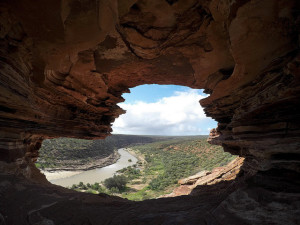 Next on our trip along the coast: Kalbarri National Park. Again, not a place where you would drive to/through with a 2WD. The road first takes you through the park, along the highway. No problem there. But once you actually get into the park, you definitely need your 4×4! Now, why all these troubles? Well … Nature has, again, done an excellent job in creating a special attraction: Nature’s Window. At a gorgeous location (literally, at the top of a gorge, divided by a meandering river) the erosion of the sandstone has created a ‘window’. The rainbow made the experience even more special 🙂 Back on the highway, the road takes you to the town Kalbarri, and further south along a spectacular coastline.
Next on our trip along the coast: Kalbarri National Park. Again, not a place where you would drive to/through with a 2WD. The road first takes you through the park, along the highway. No problem there. But once you actually get into the park, you definitely need your 4×4! Now, why all these troubles? Well … Nature has, again, done an excellent job in creating a special attraction: Nature’s Window. At a gorgeous location (literally, at the top of a gorge, divided by a meandering river) the erosion of the sandstone has created a ‘window’. The rainbow made the experience even more special 🙂 Back on the highway, the road takes you to the town Kalbarri, and further south along a spectacular coastline.
The next big town is Geraldton. This place is known for its trees, but somehow we missed them 🙂 (except for the one in town)The war memorial is also worth mentioning! It is a tribute to the lives lost on the war ship HMAS Sydney II. The view over the ocean is beautiful! There is a beautiful cathedral as well.
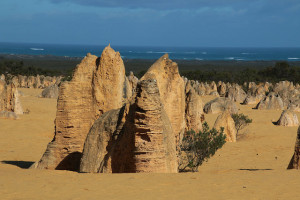 Just some hundreds of kilometers divide us from Perth. Some small coastal towns are nice to visit. And since it is only a small detour from the highway, the Nambung NP is an absolute must, just south of Cervantes! The Pinnacles Desert is the reason to stop here. Or rather, to come here and drive through the limestone pinnacles. Management has done a great job by creating a ‘road’ along the rocks, so tourists can enjoy this natural spectacle without destroying anything. The best tip we can give you is to come very early. When we drove away the other tourists came in. The road is narrow and one-way … From the desert you can look all the way to the ocean, all part of the Nambung NP. Amazing! Btw: one of those other places to see the stromatolites is Lake Thetis in Cervantes.
Just some hundreds of kilometers divide us from Perth. Some small coastal towns are nice to visit. And since it is only a small detour from the highway, the Nambung NP is an absolute must, just south of Cervantes! The Pinnacles Desert is the reason to stop here. Or rather, to come here and drive through the limestone pinnacles. Management has done a great job by creating a ‘road’ along the rocks, so tourists can enjoy this natural spectacle without destroying anything. The best tip we can give you is to come very early. When we drove away the other tourists came in. The road is narrow and one-way … From the desert you can look all the way to the ocean, all part of the Nambung NP. Amazing! Btw: one of those other places to see the stromatolites is Lake Thetis in Cervantes.
The last national park we visited before arriving in Perth was Yanchep NP. We thought to see some wild koalas there, but were a bit disappointed to learn this ‘NP’ was an upgraded park, with about 10 koalas living in a lawn, a hotel and a pound. And of course some tame kangaroos.
We drove about 3000 km from Broome to Perth, a bit faster than we planned due to the bad weather. Notwithstanding the beautiful West Coast, we were glad to arrive in Perth. After all, between all those beautiful places, there is a lot of nothing in between! Anyone planning to do the same trip should consider this. Take enough food and water with you. And it helps to have a dual (long range) fuel tank … There are good options to free camp along the highway, but going on a caravan park now and then is not a shame!
